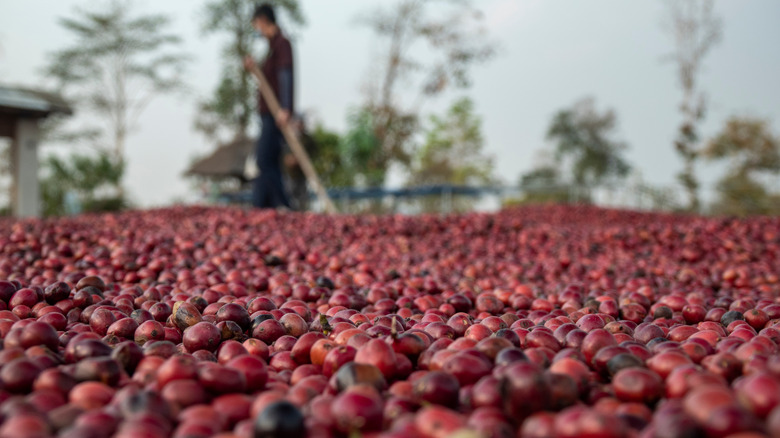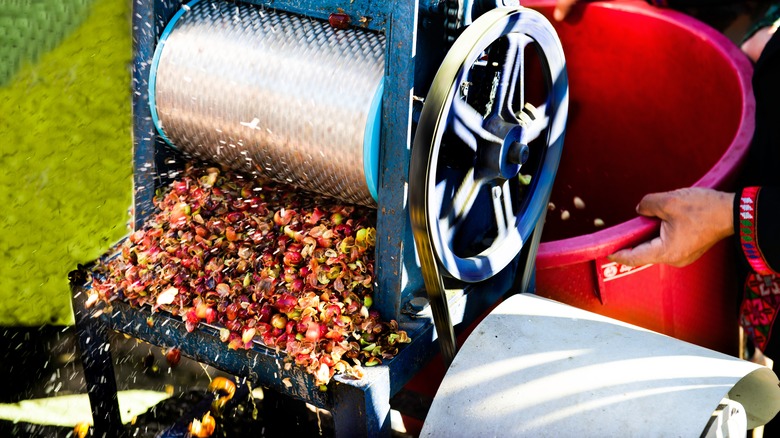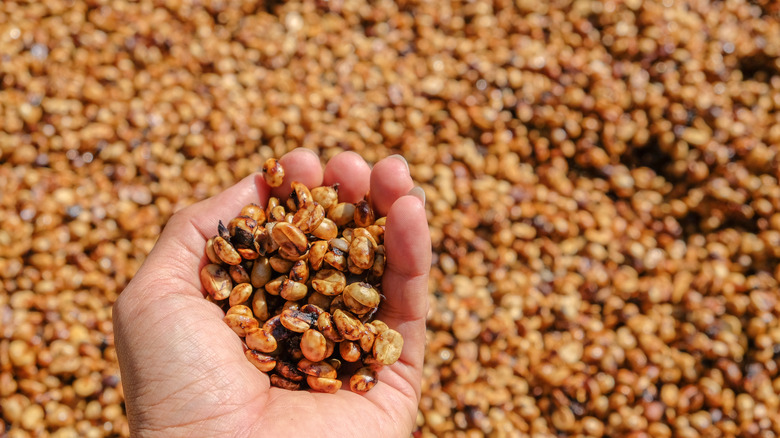The 3 Main Ways Coffee Beans Are Processed
So much goes into the cup of coffee many of us savor in the morning. Coffee beans are sourced from many countries across the globe, and where the coffee is grown — also called terroir – affects the flavor notes we perceive in the cup. Coffee beans are roasted, in a spectrum from light to dark, unlocking and enhancing the potential flavors found in green, unroasted beans, which aren't terribly appealing before they're roasted.
But long before coffee beans arrive at the roaster, they're processed immediately after ripe coffee cherries are harvested from shade-grown coffee plants, according to the National Coffee Association (NCA). How the beans are handled or processed has an enormous impact on the flavors you get in your cup of coffee. There are three main ways in which the coffee cherries can start their journey into coffee beans: dry processed, wet processed, and honey processed. Understanding the differences between these methods can both provide you with a framework to explore different flavors and help you identify which coffees you enjoy the most.
Dry processed
The overall goal of processing coffee beans is to separate the beans themselves from the entire coffee cherry and also to dry out the beans, as explained by Paulig Barista Institute. The oldest method of processing is to spread the ripe coffee cherries out whole on tables or patios so the cherries will dry in the sun. While the cherries are drying, they're turned regularly to prevent molding or rotting. This natural process is used primarily in places like Ethiopia and Brazil, where coffee farmers don't have access to ample fresh water.
Once the coffee cherries are dry, Eater explains the beans are hulled to remove the dried cherry flesh and parchment around the beans. Because the cherry pulp remains on the beans as they dry, coffee processed naturally this way can absorb tropical and strawberry flavors, along with notes of black tea, bergamot, chocolate, and blueberry. Dry processed coffee can also display strong winy, fermented notes that some coffee drinkers may not care for. When it's carefully managed, the dry process can yield beautiful and robust coffee beans.
Wet processed
The wet process begins with a pulping machine that removes the cherry pulp from the beans (via NCA). After the beans are de-pulped, they go into a fermenter that removes the rest of the material covering the coffee beans slowly over a period of 12 to 48 hours. Barista Institute notes that the beans are then dried much like the naturally processed beans are, spread out in the sun and turned often to prevent spoilage, but are also sometimes mechanically dried.
Wet processed beans tend to taste cleaner than natural process beans, according to Eater, because they don't absorb as much of the flavor of the fruit as they dry. They also tend to be brighter and have higher acidity. While acidity in the beans can rise too high, leading to a cup of coffee that may have notes of vinegar, when wet process beans are roasted and brewed, they yield a bright, delicate cup of coffee. Wet processed beans tend to cost more than dry processed ones, partly because the method is more expensive and consumes a lot of water, but also because the process is more consistent.
Honey processed
Honey processed beans are the Goldilocks of coffee beans: They're kind of a hybrid between the dry and wet process methods — a just right middle ground. Eater explains that the coffee cherries are de-pulped, but they're not fermented, leaving a bit of the pulp on the bean. Then as the beans are dried, they absorb some of the fruitiness from the cherry, but the drying is easier to control without getting the off-putting fermented flavors that some dry process beans can acquire.
Honey or pulped-naturally processed beans tend to produce coffee that's more acidic and brighter than naturally processed ones, but less acidic than wet-processed beans. Coffee brewed from honey process beans will have creamy notes and a medium body. Experimenting with coffee from different regions and different process methods can be a great adventure. And if you're feeling even more ambitious, you can even select some dry, wet, and honey-processed green coffee beans and roast them yourself at home.



